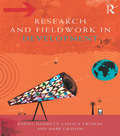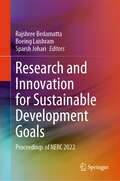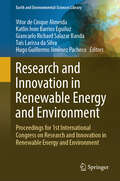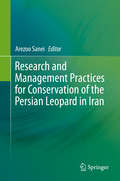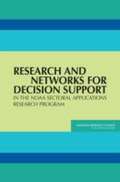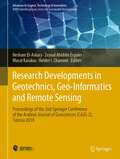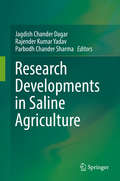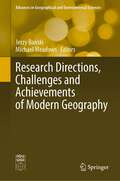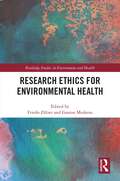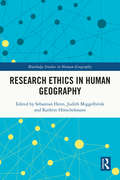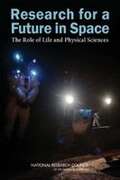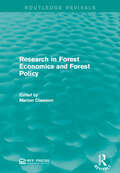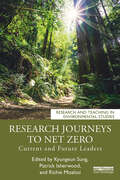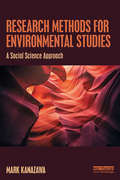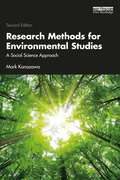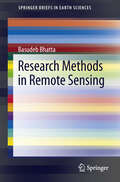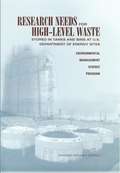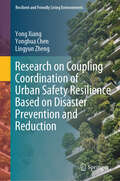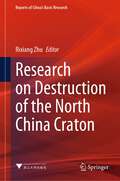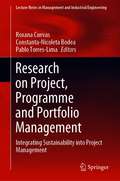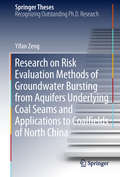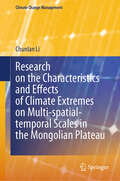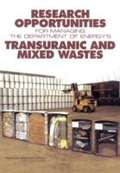- Table View
- List View
Research and Fieldwork in Development
by Daniel Hammett Chasca Twyman Mark GrahamResearch and Fieldwork in Development explores both traditional and cutting edge research methods, from interviews and ethnography to spatial data and digital methods. Each chapter provides the reader with an understanding of the theoretical basis of research methods, reflects upon their practice and outlines appropriate analysis techniques. The text also provides a cutting edge focus on the role of new media and technologies in conducting research. The final chapters return to a set of broader concerns in development research, providing a new and dynamic set of engagements with ethics and risk in fieldwork, integrating methods and engaging development research methods with knowledge exchange practices. Each chapter is supported by several case studies written by global experts within the field, documenting encounters and experiences and linking theory to practice. Each chapter is also complimented by an end of chapter summary, suggestions for further reading and websites, and questions for further reflection and practice. The text critically locates development research within the field of international development to give an accessible and comprehensive introduction to development research methods. This book provides an invaluable overview to the practice of international development research and serves as an essential resource for undergraduate and postgraduate student embarking of development fieldwork. It is supported by online resources including extended bibliographies for each chapter, example risk and ethic forms, example policy briefing notes, research reports, links to websites and data sources.
Research and Innovation for Sustainable Development Goals: Proceedings of NERC 2022
by Boeing Laishram Rajshree Bedamatta Sparsh JohariAlmost immediately after the UN Secretary-General called for a Decade of Action to deliver Sustainable Development Goals at the SDG Summit of 2019, the world faced massive COVID-19 induced disruptions at the cost to the global economy. To accelerate progress in the SDGs, the decade of 2020-2030 requires research, innovations, and commitments of various stakeholders at all levels – locally, nationally, and globally. This book contributes to the action agenda by focusing on India's opportunities and challenges, emphasizing India's northeast. Many countries have taken significant actions toward realizing the SDG mission and vision. However, due to a lack of knowledge, research, and innovation, there is a considerable disparity in the countries' actions. Few developed countries have made significant progress in realizing the SDGs, while many developing countries struggle. This book brings together diverse views on various domains of SDGs, providing a sub-national framework for addressing the gaps and meeting the goals.
Research and Innovation in Renewable Energy and Environment: Proceedings for 1st International Congress on Research and Innovation in Renewable Energy and Environment (Earth and Environmental Sciences Library)
by Vitor de Cinque Almeida Katlin Ivon Barrios Eguiluz Giancarlo Richard Salazar Banda Taís Larissa da Silva Hugo Guillermo Jiménez PachecoRenewable energies reduce dependence on fossil fuels and minimize the carbon footprint. Solar panels and wind turbines decrease emissions and costs in the industry. Socially, they benefit disconnected communities, improving quality of life and providing opportunities. Sustainable development seeks equity and social inclusion, driving sustainable energy solutions. Renewable energies promote a prosperous and equitable future, addressing environmental and economic challenges. The energy transition is everyone's responsibility to ensure a greener and brighter tomorrow. On the other hand, environmental biotechnology and marine biology are fundamental to address environmental challenges. Research on treating effluents from the dairy, textile, and mining sectors seeks solutions to reduce water pollution. Industrial waste valorization through biotechnology aims to decrease pollution and resource depletion. The production of bio-products, biomaterials, bioplastics, and biofuels offerssustainable alternatives with a lower carbon footprint. Marine biology focuses on understanding and conserving aquatic ecosystems in the face of climate change and human influence. Biotechnology also contributes to the sustainable use of national biodiversity, with applications in pharmaceutical, cosmetic, and agricultural industries. These multidisciplinary fields are advancing towards a more sustainable and environmentally friendly future. The conference proceedings will consist of original research articles, reviews, and short communications covering several types of renewable energies: Solar including photovoltaic cells or solar thermal systems, Wind, Hydropower, Biomass-based energy, Geothermal, Waves Energy, Hydrogen, Bioenergy, or energy from biological processes, and fuel cell systems. In addition, studies focused on Environmental Biotechnology, including Bioremediation, Bioenergy Production, Microbial Fuel Cells, Waste Valorization, Microplastic Biodegradation, Biodegradable Materials and Phytoremediation, as well as focused on Marine Biology, including Marine Biodiversity and Conservation, Marine Genomics, Ocean Acidification, Marine Ecotoxicology, and Marine Biotechnology and Microbiology. Other environmental areas of research can be also included such as industrial wastewater systems or the development of sustainable solutions for a healthier and more resilient environment.
Research and Management Practices for Conservation of the Persian Leopard in Iran
by Arezoo SaneiThe population of the Persian leopard (Panthera pardus saxicolor) has drastically declined; this Asian leopard subspecies has disappeared from some parts of its former range. Containing large areas of potential habitats with leopard presence across almost all of its provinces, Iran is known to be the last stronghold for the Persian leopard in the region. This book comprehensively covers research, management and conservation practices of the Persian leopard, including:· The first phase of the Persian Leopard National Action Plan in Iran together with an innovative leopard insurance program and a contingent valuation practice with respect to the wildlife trafficking law enforcement in Iran· Research on a hypothesis about the risk of a major fragmentation and splitting the leopard distribution range in Iran into a northern and a southern parts· An innovative and empirically fitted species- and region-specific approach for assessing the cumulative effect of land use and land cover changes on the leopard persistence· Distribution modeling of leopard potential habitats on a regional basis, accompanied by ground validation techniques· An evaluation to three threshold rules to define the habitat suitability indices· Persian leopard habitats and relative corridors in the trans-boundary areas of the East Azarbaijan province of the northwest of Iran in the Caucasus Ecoregion. The innovative research and conservation approaches presented in this book will be of great interest to those studying the leopard and other large carnivore species. The innovative models presented in this book about cumulative effect of the land use and land cover changes will be beneficial to land use managers, planners and decision makers in selecting wildlife friendly solutions for development programs. The strategic and action planning model as well as the leopard compensation program as an insurance scheme are developed specifically for the local condition and leopard status in Iran.
Research And Networks For Decision Support: In The Noaa Sectoral Applications Research Program
by National Research Council of the National AcademiesThis study recommends a definition of “decision support” that emphasizes communication rather than translation and a strategy by which the small NOAA Sectoral Applications Research program can advance decision support. The book emphasizes that seasonal climate forecasts provide fundamentally new kinds of information and that integrating this information into real-world decisions will require social innovations that are not easily accomplished. It recommends that the program invest in (a) research to identify and foster the innovations needed to make information about climate variability and change more usable in specific sectors, including research on the processes that influence success or failure in the creation of knowledge-action networks for making climate information; (b) workshops to identify, catalyze, and assess the potential of knowledge-action networks in particular resource areas or decision domains; and (c) pilot projects to create or enhance these networks for supporting decisions in climate-affected sectors. It recommends that evaluation of the program be addressed with a monitoring approach.
Research Developments in Geotechnics, Geo-Informatics and Remote Sensing: Proceedings of the 2nd Springer Conference of the Arabian Journal of Geosciences (CAJG-2), Tunisia 2019 (Advances in Science, Technology & Innovation)
by Zeynal Abiddin Erguler Murat Karakus Helder I. Chaminé Hesham El-AskaryThis book contains the best peer-reviewed papers accepted for presentation at the 2nd Springer Conference of the Arabian Journal of Geosciences (CAJG-2), organized in Sousse, Tunisia, in November 2019. The short papers cover various topics from the fields of (1) geological and geotechnical engineering, (2) geomechanical studies based on numerical and analytical methods, and (3) geo-informatics and remote sensing. The content of these papers provides new scientific knowledge for further understanding on landslides, new stabilization techniques, importance of geophysics for engineering geology investigations as well as new empirical approaches for easily predicting some physical and hydrogeomechanical properties of geomaterials. The book is of interest to all researchers, practitioners, and students in the fields of geological and mining engineering, geotechnical engineering, hydrogeomechanics, engineering geology, geotechnologies, and natural hazards.
Research Developments in Saline Agriculture
by Jagdish Chander Dagar Rajender Kumar Yadav Parbodh Chander SharmaSoil and water salinity is a major challenge for the agricultural community and policy makers in terms of meeting the burgeoning population’s demand for food and other agricultural commodities. In coastal regions, climate change and sea level rise will aggravate the problem with more and more areas becoming saline due to intrusion of sea water. As such there is a pressing need for modern tools and innovative techniques for the identification of salty soils and poor-quality waters, crop production, soil reclamation and lowering the water table in waterlogged areas. Tackling next-generation problems such as contamination of soil and underground water due to fluoride and arsenic, as well as developing multi-stress tolerant crops is also a high priority. Further, techniques for domesticating halophytes, mangrove-based aquacultures, using seaweed cultures as agricultural crops and integrated farming systems need to be perfected. This book addresses all these aspects in detail, highlighting the diverse solutions to tackle the complex problem of salinity and waterlogging and safer management of poor-quality waters. With chapters written by leading experts, it is a valuable resource for researchers planning future investigations, policy makers, farmers and other stakeholders, and for students wanting insights into vital issues of environment.
Research Directions, Challenges and Achievements of Modern Geography (Advances in Geographical and Environmental Sciences)
by Jerzy Bański Michael MeadowsThis book identifies and discusses research directions, challenges and achievements in contemporary geography. It also documents the most current theoretical and methodological considerations undertaken by scientists representing various sub-disciplines of geography with particular reference to human geography. It was assumed that the thematic structure of the currently active International Geographical Union (IGU) problem commissions corresponds to the most relevant and current research directions in geography. Reflecting this assumption, the book consists of 14 chapters contributed by geographers representing 14 problem commissions of the IGU, which allows us to examine geography from different perspectives and to provide the reader with a complete overview of contemporary research issues in human geography. The first part discusses contemporary research problems and issues related to scientific methodology and achievements of selected geographical sub-disciplines, including urban geography, agricultural geography, transport geography, and political geography, among others. The second part focuses on the interdisciplinarity of geography and the topics of global dimension undertaken by geographers such as global change, GIS and geospatial technology, marginalization, and environmental change. This part also discusses the internal relations between geographical specializations and their links with other related sciences, including geology, sociology, and economics. The third part discusses the holistic approaches of geography applied to particular regions, territories, or conditions (Africa, costal systems, geomorphology and local development).
Research Ethics and Integrity During Pandemics: Developing the PREPARED Code (SpringerBriefs in Research and Innovation Governance)
by Kate Chatfield Michelle SinghThis open-access book is an essential read for anyone interested in pandemic preparedness, research governance, and the ethical oversight of research. It examines the development of a pioneering research ethics framework designed for use during pandemics, guiding readers through the careful development of the PREPARED Code, while highlighting the key steps and lessons learned. The book also underscores the importance of supportive measures, such as user-friendly ethics training, to ensure effective implementation. Drawing from these insights, it offers recommendations for others seeking to develop their own clear, engaging, and accessible ethics code.
Research Ethics for Environmental Health (Routledge Studies in Environment and Health)
by Friedo ZölzerResearch Ethics for Environmental Health explores the ethical basis of environmental health research and related aspects of risk assessment and control. Environmental health encompasses the assessment and control of those environmental factors that can potentially affect human health, such as radiation, toxic chemicals and other hazardous agents. It is often assumed that the assessment part is just a matter of scientific research, and that control is a matter of implementing standards that unambiguously follow from that research. But it is less commonly understood that environmental health also requires addressing questions of an ethical nature. Coming from multiple disciplines and nine different countries, the contributors to this book critically examine a diverse range of ethical concerns in modern environmental health research. This book will be of great interest to scholars and practitioners of environmental health, as well as researchers in applied ethics, environmental ethics, medical ethics, bioethics and those concerned with chemical and radiation protection.
Research Ethics in Human Geography (Routledge Studies in Human Geography)
by Sebastian Henn Judith Miggelbrink Kathrin HörschelmannThis book explores common ethical issues faced by human geographers in their research. It offers practical guidance for research planning and design that incorporates geographic disciplinary knowledge to conceptualise research ethics. The volume brings together international insights from researchers in geography and related fields to provide a comprehensive overview of relevant ethical frameworks and challenges in human geography research. It includes in-depth reflections on a range of ethical dilemmas that arise in certain contextual conditions and spatial constructions that face those researching and teaching on spatial dimensions of social life. With a focus on the increased need for specialist ethics training as part of postgraduate education in the Humanities and Social Sciences and the necessity for fostering sensitivity in cross-cultural comparative research, the book seeks to enable people to engage in ethical decision-making and moral reasoning while conducting research. Chapters examine the implications of geographical research for conceptualising ethics and discuss specific case studies from which more general conclusions, linked to conceptual debates, are drawn. As a research-based reference guide for tackling ethically sensitive projects and international differences in legal and institutional standards and requirements, the book is useful for postgraduate and undergraduate students as well as academics teaching at senior levels.
Research for a Future in Space: The Role of Life and Physical Sciences
by Committee for the Decadal Survey on Biological Physical Sciences in SpaceDuring its more than 50-year history, NASA's success in human space exploration has depended on the agency's ability to effectively address a wide range of biomedical, engineering, physical sciences, and related obstacles. This achievement is made possible by NASA's strong and productive commitments to life and physical sciences research for human space exploration, and by its use of human space exploration infrastructures for scientific discovery. Research for a Future in Space: The Role of Life and Physical Sciences explains how unique characteristics of the space environment can be used to address complex problems in the life and physical sciences. This booklet also helps deliver both new knowledge and practical benefits for humankind as it embarks on a new era of space exploration. Research for a Future in Space: The Role of Life and Physical Sciences is based on the in depth report, Recapturing a Future for Space Exploration: Life and Physical Sciences Research for a New Era. To learn more about the future of space exploration, visit our catalog page and download this report for free.
Research in Forest Economics and Forest Policy (Routledge Revivals)
by Marion ClawsonIn order to fill a growing need for research into forestry issues, Resources for the future held a symposium in 1977.Orignally published in the same year, all papers in this collection were written specifically for this symposium to highlight the most important forestry issues including pricing policy, supply and demand and the role of the public and private forestry sector. This title will be of interest to Environmental Students and professionals.
Research Journeys to Net Zero: Current and Future Leaders (Research and Teaching in Environmental Studies)
by Kyungeun Sung Patrick Isherwood Richie MoalosiThis book provides useful insight into how academics from diverse disciplinary backgrounds, such as science, engineering, technology, social science, policy, design, architecture, built environment, business, and management, have been conducting research into how to realise net zero emissions to address climate change. This book explores the ways in which countries around the world have pledged to achieve net zero emissions through decarbonisation processes. It presents the highest calibre research and impact activities carried out in the UK, Europe, North America, Australia, Asia, and Africa. Such activities include conceptualisation, opportunity identification, specific case studies, demonstration of proof of concepts, provision of evidence, education of the general public, and knowledge transfer to companies. Further to this, the chapters also bring to light personal career journeys to net zero by current and future international research leaders. From this book, readers will gain a full understanding of net zero research via multiple disciplinary pathways, be inspired by personal accounts, and will learn key methodologies, including quantitative and qualitative approaches. The diversity of authors and topics make the book widely applicable to a range of fields, and it will be of great interest to researchers, students, practitioners, and decision makers working towards the goals of net zero and decarbonisation.
Research Methods for Environmental Studies: A Social Science Approach
by Mark KanazawaThe methodological needs of environmental studies are unique in the breadth of research questions that can be posed, calling for a textbook that covers a broad swath of approaches to conducting research with potentially many different kinds of evidence. Written specifically for social science-based research into the environment, this book covers the best-practice research methods most commonly used to study the environment and its connections to societal and economic activities and objectives. Over five key parts, Kanazawa introduces quantitative and qualitative approaches, mixed methods, and the special requirements of interdisciplinary research, emphasizing that methodological practice should be tailored to the specific needs of the project. Within these parts, detailed coverage is provided on key topics including the identification of a research project; spatial analysis; ethnography approaches; interview technique; and ethical issues in environmental research. Drawing on a variety of extended examples to encourage problem-based learning and fully addressing the challenges associated with interdisciplinary investigation, this book will be an essential resource for students embarking on courses exploring research methods in environmental studies.
Research Methods for Environmental Studies: A Social Science Approach
by Mark KanazawaThe methodological needs of environmental studies are unique in the breadth of research questions that can be posed, calling for a textbook that covers a broad swath of approaches to conducting research with potentially many different kinds of evidence. Fully updated to address new developments such as the effects of the internet, recent trends in the use of computers, remote sensing, and large data sets, this new edition of Research Methods for Environmental Studies is written specifically for social science-based research into the environment. This revised edition contains new chapters on coding, focus groups, and an extended treatment of hypothesis testing. The textbook covers the best-practice research methods most used to study the environment and its connections to societal and economic activities and objectives. Over five key parts, Kanazawa introduces quantitative and qualitative approaches, mixed methods, and the special requirements of interdisciplinary research, emphasizing that methodological practice should be tailored to the specific needs of the project. Within these parts, detailed coverage is provided on key topics including the identification of a research project, hypothesis testing, spatial analysis, the case study method, ethnographic approaches, discourse analysis, mixed methods, survey and interview techniques, focus groups, and ethical issues in environmental research. Drawing on a variety of extended and updated examples to encourage problem-based learning and fully addressing the challenges associated with interdisciplinary investigation, this book will be an essential resource for students embarking on courses exploring research methods in environmental studies.
Research Methods in Remote Sensing
by Basudeb BhattaThis book introduces the overall concepts of research methods in Remote Sensing. It also addresses the entire research framework, ranging from ontology to documentation. As such, it covers the theory while providing a solid basis for engaging in concrete research activities. It is not intended as a textbook on remote sensing; rather, it offers guidance to those conducting research by examining philosophical and other issues that are generally not covered by textbooks. Various stages of research are discussed in detail, including illustrative discussions and helpful references. The topics considered in this book cover a part of the research methodologies explored in Master of Philosophy (M.Phil.) and Doctor of Philosophy (Ph.D.) programs. The book's physical format has been kept to a compact, handy minimum in order to maximize its accessibility and readability for a broad range of researchers in the field of remote sensing.
Research Methods of Environmental Physiology in Aquatic Sciences
by Kunshan Gao David A. Hutchins John BeardallThis book presents methods for investigating the effects of aquatic environmental changes on organisms and the mechanisms involved. It focuses mainly on photosynthetic organisms, but also provides methods for virus, zooplankton and other animal studies. Also including a comprehensive overview of the current methods in the fields of aquatic physiology, ecology, biochemistry and molecular approaches, including the advantages and disadvantages of each method, the book is a valuable guide for young researchers in marine or aquatic sciences studying the physiological processes associated with chemical and physical environmental changes.
Research Needs For High-level Waste Stored In Tanks And Bins At U.s. Department Of Energy Sites: Environmental Management Science Program
by Committee on Long-Term Research Needs for Radioactive High-level Waste at Department of Energy SitesThe committee was charged to identify high-level waste problems that cannot be addressed effectively with current technologies, and to recommend areas of research by which the Department's Science Program can make significant contributions to solving these problems and adding to scientific knowledge generally. The members were selected for their expertise in various relevant fields. The report is not indexed. Annotation c. Book News, Inc. , Portland, OR (booknews. com)
Research on Coupling Coordination of Urban Safety Resilience Based on Disaster Prevention and Reduction (Resilient and Friendly Living Environments)
by Yong Xiang Yonghua Chen Lingyun ZhengThis book examines the connotations of the urban safety resilience system and the operational mechanisms of its subsystems. By employing a coupled coordination model, we conduct evaluative analyses across the personnel-facility-management dimensions of urban safety resilience. We provide a comprehensive perspective to help readers understand how disaster risk reduction theories can be applied to various subsystems of urban safety resilience, optimizing disaster management measures in different cities. This book is intended to provide practical guidance for urban planners, policymakers, and researchers, while also being accessible to general readers interested in urban development. The extensive experience and in-depth research of the author's team make this book a valuable reference for those seeking to explore urban safety resilience.
Research on Destruction of the North China Craton (Reports of China’s Basic Research)
by Rixiang ZhuThis book mainly introduces overview of “Destruction of the North China Craton”, a major research plan of NSFC. It summarizes the scientific ideas, core key scientific issues, scientific research objectives, and models of the major research plan of "Destruction of the North China Craton". From the perspective of major national needs and scientific discipline development, the book focuses on the following aspects: the temporal and spatial distribution range, process, and mechanism of the NCC destruction; the properties, structure, and interaction of materials in different spheres in the earth during craton destruction; the shallow effect of craton destruction; and the control mechanism of mineral resources, energy, and disasters. The book also makes a strategic prospect for the study of global dynamics and improves human understanding of the formation and evolution of continents.
Research on Project, Programme and Portfolio Management: Integrating Sustainability into Project Management (Lecture Notes in Management and Industrial Engineering)
by Roxana Cuevas Constanta-Nicoleta Bodea Pablo Torres-LimaThis book collects recent work presented at the 31st IPMA Congress, which was held in Merida, Mexico, from September 30th to October 2nd, 2019. It covers a range of project, programme and portfolio management contexts, with the general aim of integrating sustainability into project management.The book is structured into three parts. The first part covers concepts and approaches related to the integration of sustainability in project management. The second part presents research on integrating sustainability into project management in different industries and regions. The final part takes specific perspectives on integrating sustainability into project management related to learning and continuing competence development. The book offers a valuable resource for all researchers interested in studying the emerging trends in incorporating sustainability in project, programme and portfolio management.
Research on Risk Evaluation Methods of Groundwater Bursting from Aquifers Underlying Coal Seams and Applications to Coalfields of North China (Springer Theses)
by Yifan ZengThis book provides an information fusion model with information fusion theory, geographic information system technology and modern mathematical methods to evaluate the risks of groundwater inrushes from aquifers underlying coal seams. In this new model, the water inrush vulnerable index was calculated with variable weights theory. It overcomes the defect of the traditional vulnerability index method that assumes constant weights for the factors controlling the water inrush. Mine water inrush events often occur during coal mine construction and production; they account for a large proportion of the nation’s coal mine disasters and accidents in China. Between 2005 and 2014, 513 water inrush incidents have occurred with a total loss of 2,753 lives. As mining depths and mining intensity continue to increase, the hydrogeological conditions encountered are becoming more complex. The innovative model presented here was applied to two coal mines in China with proved better results than the traditional vulnerability index method.
Research on the Characteristics and Effects of Climate Extremes on Multi-spatial-temporal Scales in the Mongolian Plateau (Climate Change Management)
by Chunlan LiCompared with average climate changes, climate extremes which are considered as low-probability events have greater impacts on natural and social systems due to their suddenness, unpredictability and strong destructiveness. Located in the typical arid–semiarid climate transition zone, the Mongolian Plateau, dominated by herbage animal husbandry, is greatly affected by climate extremes, and its ecosystem is extremely fragile. In the context of global warming, the spatial-temporal variation research about climate extremes and their impacts on vegetation is not only beneficial to the protection of the grassland ecological environment in the Mongolian Plateau, but also of great significance to formulate an effective meteorological disaster risk management.Based on daily highest temperature, daily minimum temperature and daily precipitation dataset of 111 meteorological stations over Mongolian Plateau from 1961 to 2014. Firstly, sixteen extreme temperature indices and eleven extreme precipitation indices were calculated. Then, multi-spatial-temporal characteristics of climate extremes in the scope of intensity, duration and frequency were analyzed. At the same time, the vegetation variations were analyzed based on GIMMS NDVI3g data. Thirdly, correlation analysis and multiple stepwise regression analysis were used to analyze the relationships between extreme climate indices and NDVI in different spatial scales from the perspective of single factor and multiple factors, respectively. Finally, the future change of climate extremes in duration were explored based on the climate model data. At the same time, the vulnerable areas of grassland and forest were also identified, and adaptive options of different scales were proposed.Researchers engaged in extreme climate change and managers of government departments are the readership/primary audience for the work.
Research Opportunities For Managing The Department Of Energy's Transuranic And Mixed Wastes
by Committee on Long-Term Research Needs for Managing Transuranic Mixed Wastes at Department of Energy SitesAbout 155,000 cubic meters of waste contaminated with both radioactive isotopes and hazardous chemicals are stored at some 30 DOE sites, and another 450,000 cubic meters are buried. While DOE is making a concerted effort to properly dispose of this waste, the amount translates to a multi-decade effort that will require handling, characterizing, and shipping hundreds of thousands of waste containers at a total cost of billions of dollars. This report describes basic scientific research that can lead to new technologies for performing these tasks more safely and cost effectively.
